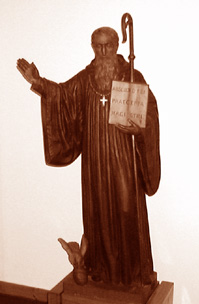 St. Benedict was born about 480 AD. in the mountains of the Italian
district of Nursia, about 75 miles north of Rome. His life is somewhat
historically obscure: not a single contemporaneous biography was written
and Benedict mentions himself not even once in his great Rule. Thus,
our chief source of information is generally a late sixth century work
by Pope St. Gregory the Great called "The Dialogues".
St. Benedict was born about 480 AD. in the mountains of the Italian
district of Nursia, about 75 miles north of Rome. His life is somewhat
historically obscure: not a single contemporaneous biography was written
and Benedict mentions himself not even once in his great Rule. Thus,
our chief source of information is generally a late sixth century work
by Pope St. Gregory the Great called "The Dialogues".
Though the Dialogues are not "history" as we know it, they do tend to give us some details about St. Benedict that are regarded as accurate. Benedict was from a noble family and as a young man was sent to study in Rome. He was repulsed by the moral decadence he found there and so set off at the age of twenty for Enfide, a village thirty miles to the east. Later he traveled to the mountainous region of Subiaco where he lived in the solitude for three years.
St. Gregory's Dialogues illustrate in stories the key aspects of St. Benedict's personality. The beginnings of Benedict's monastic life depict a young man who grows in spiritual maturity through a series of confrontations with temptation. Benedict emerges from these struggles a victorious "Man of God" whose goodness becomes well known even from the isolation of his hermitage.
Benedict's close relationship with God is manifested through his gifts of miracles and prophecy and by God's constant protection. For instance, when Benedict agrees to become superior of a group of "false monks" in the town of Vicovaro, they turn in rebellion against him and his holy rule of life. But when the men resort to poisoning his food, the vessel of poisoned wine they had prepared for him shatters as he makes the customary blessing over it. Thus the famous inscription found on the cross of St. Benedict: "Begone Satan! and suggest not to me thy vain things: the cup thou profferest me is evil; Drink thou thy poison."
Benedict started twelve small communities of monks in the vicinity of Subiaco, before traveling fifty miles to the south to form a large monastic community, the famous Monte Cassino. Here he wrote "The Rule" for which he is known and revered throughout the world. This document more than anything else, reveals to us the mind and heart of Benedict. He is eclectic, taking his monastic instruction from whatever source is useful for his monks. He is humble, insisting that monastic superiors listen to their subjects, even the youngest when making decisions for if one does "everything with counsel (he) will not be sorry afterward". He is a realist, sensitive to the needs of his individual monks, concerned first and foremost for the good of their souls. Lastly, he is passionate: passionate for the "Work of God", the liturgical prayer celebrated by the monks, passionate for visitors, who are to be "welcomed as Christ", passionate for the care of the sick, and the weak, "that no one be disquieted or distressed in the house of God".
Benedict died at Monte Cassino about 547 AD. His spirit, however, lives on in the lives of the men and women who have dedicated themselves to the following of his rule of life, to life in monastic community, to "prayer and work", and to the search for God that will bring us "all together to everlasting life". St. Benedict, Father of monks, pray for us!